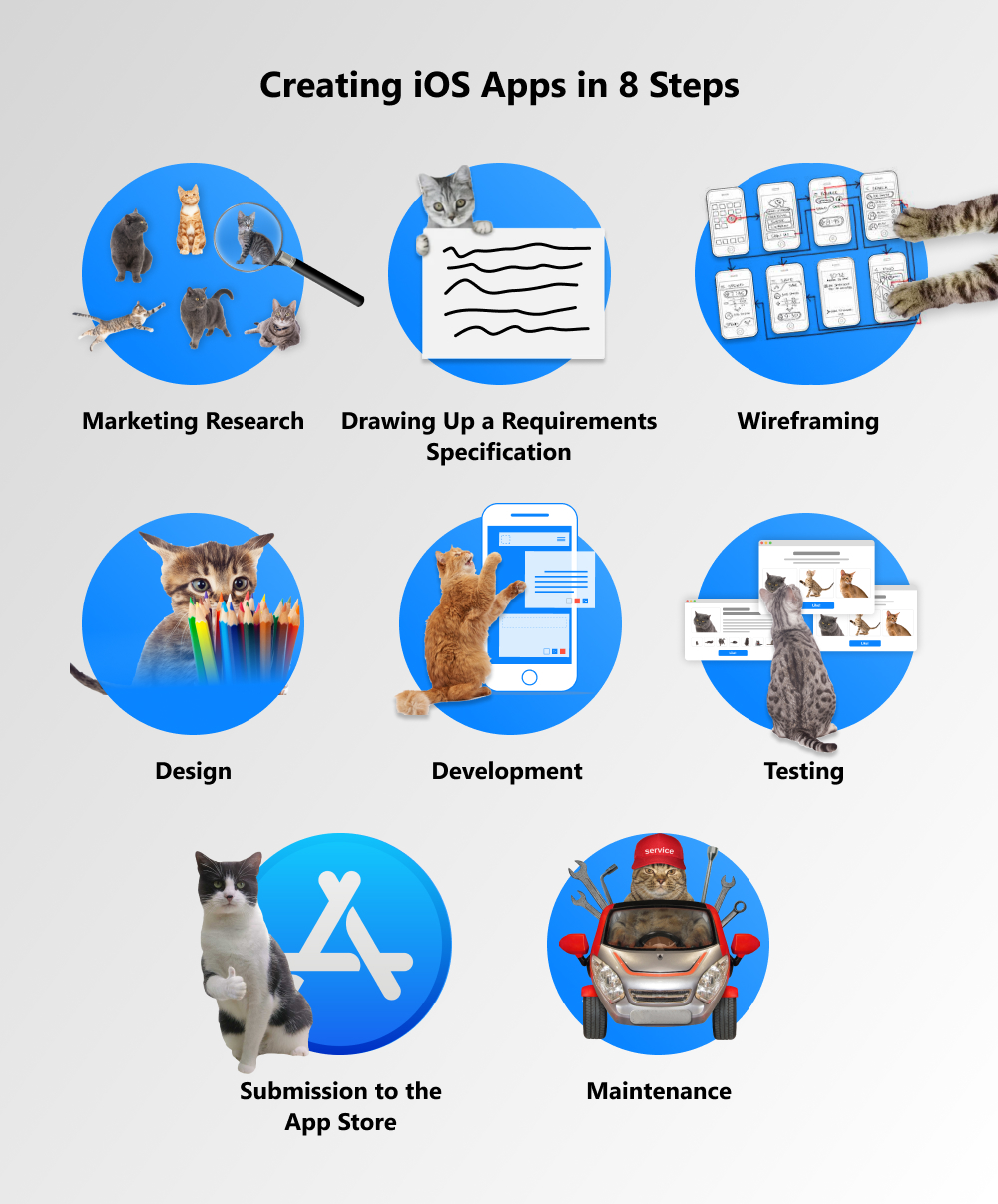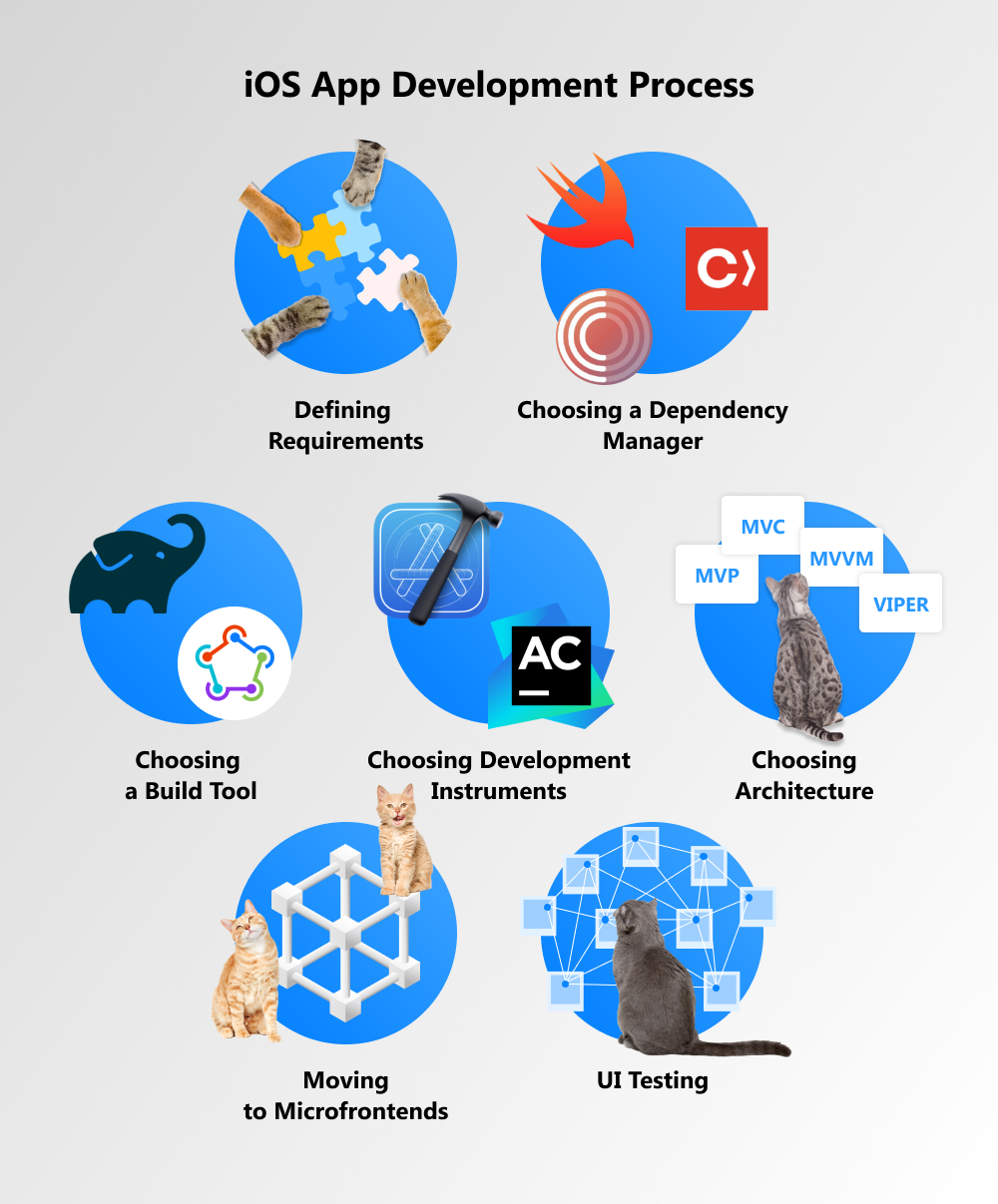The mobile application market has significantly grown recently. Sensor Tower revealed that consumers had already spent $41.5 billion on iOS apps in H1 2021 (up 22% compared to the same period last year). It's a great time for every app development company to take advantage of the situation and meet customer demand. However, developing an app is half the battle; your iOS mobile application must be secure, user–friendly, and able to solve the problems of your customers. In our article, we're going to discuss the iOS app development process, necessary infrastructure and tools, as well as the publication of your product in Apple's App Store.
written by:
Ivan Tsvirko
Senior iOS Developer, Qulix Systems
The mobile application market has significantly grown due to the pandemic and COVID–19 restrictions. When shopping malls, offices, and educational institutions closed, people began to use mobile devices more often for shopping, communication, learning, and entertainment. Sensor Tower revealed that consumers had already spent $41.5 billion on iOS apps in H1 2021 (up 22% compared to the same period last year). It's a great time for every app development company to take advantage of the situation and meet customer demand. However, developing an app is half the battle; your iOS mobile application must be secure, user–friendly, and able to solve the problems of your customers. In our article, we're going to discuss the iOS app development process, necessary infrastructure and tools, as well as the publication of your product in Apple's App Store.
Contents
8 Steps of iOS App Development Process
From a broader point of view, the process of creating a mobile app consists of the following stages:
Step 1 Marketing Research
As usual, it all starts with an idea. Do you think that you have come up with a wonderful application that will conquer all users and take first place in the market? Are you ready to run to the developers who will bring your idea to life? Wait, it's not time yet. First, you need to study existing similar solutions, analyze your competitors, determine the target audience and explore the behavior of your customers. Analytics will allow you to understand how to make your app as user–friendly as possible so that people will choose and download it. Moreover, the information obtained during the market research will help you decide on the design and features of the future product. According to the statistics, users uninstall almost 1 in every 2 mobile apps within one month. Don't let your iOS app join this group!
Step 2 Drawing Up a Requirements Specification
You need to be very careful about drawing up a requirements specification since the final result depends on it. It usually includes the following information:
- a detailed description of the features of your iOS app;
- the requirements for the application like security, interface, performance, and others;
- the project budget;
- the app development terms.
Creating a requirements specification ensures that the customer and the development company clearly understand each other regarding product requirements. A clear description of the functions and appearance of the solution will help developers create the desired iOS application.
Step 3 Wireframing
No matter how well you have written your requirements specification. There is always a risk that you may not get the product you want. In order not to waste time and money on the app development process, you can create a prototype and see how it will interact with the user. In fact, this is a mobile app with all the interfaces, buttons, and other elements that you can click, evaluate, and understand whether you need to make any changes and improvements.
Step 4 Design
When your prototype is ready, the errors are fixed, and you have an idea of how your mobile app will work, the development process can move to the design stage. The designers will create all the screens of the application in accordance with the Human Interface Guidelines prepared by Apple. The recommendations are changed and supplemented from time to time; therefore, it's worth re–reading them regularly — this will help you keep up with the ongoing changes and current trends. The designers are not only responsible for color and style. They think over the logic of the interaction of interface components. Their task is to create an attractive, responsive, and easy–to–use app.
Step 5 Development
So, the fun begins right now. The designers transfer the app design mockups to the developers so that they will be able to get started. This stage includes 2 phases of the iOS application development process: back–end development and front–end development. Back–end developers work upon the server–side of the application, which is responsible for transferring data between users or resources. They develop the server architecture (data loading algorithms, authorization methods, caching, and much more), an API (application programming interface that connects the internal and external interfaces of the mobile app), the administrative panel, and so on. The front–end developers build the client–side of the app. Simply put, this is what users see when they open a mobile application.
Step 6 iOS App Testing
The application is then handed over to the testing team, who tests how it works and fixes bugs, if any. Never neglect the testing stage as post–release bug fixes can cost you money, time, and, most importantly, your reputation. As a rule, testers check the app's performance, responsiveness, navigation, usability, security, and other features.
Step 7 Submission to the App Store
When the QA specialists test your mobile app, it is ready for release and submission to the Apple App Store. Take this procedure carefully since the store checks all the mobile applications and can reject them for any reason. Make sure that your app for iOS complies with the App Store Guidelines. The registration process usually takes two to four weeks and costs $99 per year. Here you can find the detailed instruction on how to successfully submit your iOS app to the App Store.
Step 8 Maintenance
After the release, don't forget about the app, as users will leave feedback, according to which you may need to make changes or add new features. Also, the operating system is constantly being updated, so you will need to ensure that your iOS app is compatible with new versions. Competitors don't sleep, and you will have to regularly keep your finger on the pulse so that your application will always be in trend and meet the users' expectations.
Well, we've looked at the general stages of mobile application creation. Now, let's speak about the iOS app development process itself.
iOS Development: How to Make It Right?
First of all, let us remind you that iOS app developers usually create apps in two programming languages. This is Objective–C, which was created by Apple for iOS mobile app development, and Swift, which is considered to be more advanced and modern than Objective–C. What else should you take into account except for the programming language?
Defining the project requirements is critical because it will answer the question of how long the app development process will take and how much it will cost. There are 2 options:
Option 1
You already know what solution you want. For example, you need a simple app or just want to check if your iOS app will be in demand to decide what to do next. Then it will be enough to hire a small development team and make a minimum viable product (MVP), a demo version with simplified functionality, collect feedback from users, and define the next steps. If your iOS app gains popularity, you will be able to expand it by adding new features and move to the second option.
Option 2
You're planning to develop a complex solution that requires more effort, a larger development team, more time, and more money. In this case, you should seriously think over the project infrastructure that includes:
Choosing a Dependency Manager
Simply put, a dependency manager is a tool that helps developers create apps faster and reduces the development cost. It's no secret that app developers often use third-party frameworks and libraries to simplify and fasten the iOS app development process. However, they have to keep track of updates, manually remove the old versions, and install the new ones. The dependency managers are designed to solve this issue by doing all these actions automatically. There are various dependency managers for iOS, the most popular of which are CocoaPods, Swift Package Manager, and Carthage.
App developers appreciate CocoaPods for stability and ability to easily and quickly connect various tools, utilities, and frameworks. It has over 75k libraries and is used in more than 2.4 million applications. Swift Package Manager was created by Apple to automate the process of installing dependencies. Carthage is another instrument known for its simplicity and flexibility.
Choosing a Build Tool
A build system is a tool that simplifies the process of testing and publishing an application in Apple's App Store. It allows you to build the artifact at any development stage in 1 click and see how it works. For example, if testers want to check the app, they won’t need to ask developers to build it or use any additional services. Gradle and Fastlane are the most popular build tools among specialists.
Choosing Development Instruments
Many iOS developers prefer to use XCode or AppCode that allow them to write codes and run them on iPhones, iPads, and other devices. Xcode is an integrated development environment that provides programmers with the set of tools to create apps for iPhone, iPad, Mac, Apple Watch, and Apple TV. It helps them work effectively on both small and large projects.
Another well-known IDE is AppCode, which also contains a full set of necessary instruments for comfortable operation. It accelerates the development process, monitors code quality, provides autocompletion, and much more. It is compatible with Xcode, CocoaPods, test frameworks, bug trackers, etc.
Choosing Architecture
The architecture is selected for each specific project. In the future, this will allow you to easily and quickly expand and change the set of features of the app, if necessary. It can be MVP, MVC, MVVM, or VIPER. All these patterns have one goal, which is to separate the data from the user interface. They have their own advantages and disadvantages and should be chosen depending on your project, skills and experience of your team, the complexity of the application, and the available development tools.
Moving to Microfrontends
By the way, if your iOS app expands and several development teams are working on it simultaneously, you may break the monolith into microfrontends. The monolith doesn't scale well and is difficult to maintain, develop, and test. If it's hard to create an entire app, you need to divide it into parts and develop it separately.
UI Testing
Developers can test your app by themselves before the testing phase. They write automated UI tests in order to test the features and make sure that the app operates well and smoothly.
Bottom Line
Mobile apps have already become an integral part of our life. People use them for data exchange, communication, education, business, shopping, and much more. Accordingly, they want applications to be simple, convenient, and secure. To meet user expectations, companies should seriously take the mobile app development process and be carefully prepared for each stage.
If you have any questions regarding the iOS app development, don't hesitate to contact us. For more detail, please visit our website or get in touch with our support team.

Contacts
Feel free to get in touch with us! Use this contact form for an ASAP response.
Call us at +44 151 528 8015
E-mail us at request@qulix.com








